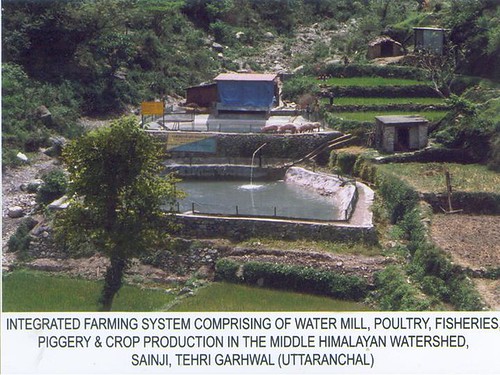
Watershed management, which is an integrated set of soil and water conservation techniques that retain runoff and so increase water availability, can provide an environment for fisheries development for food or trade. Fish found in streams and rivers serve as a source of food in varying degrees for about 40% of the households in the mid-Himalayas, which lie between the Siwaliks and the Great Himalayas at an altitude of 3,700 to 4,500 metres. However declining flows in streams and rivers, combined with unsustainable fishing practices, have led to a decline in fish availability.
Fisheries must be developed by using the potential of farm ponds and other such structures for hosting fish. Fish farming in farm ponds and Water Harvesting Structures (WHS) yields 3.5-4.5 t ha-1 year-1 and integrated fish farming enhances profits while also minimizing resource used. However, fisheries are currently not integrated in soil and water conservation measures, which wastes an opportunity for synergy.
 The Watershed-based Fisheries Development Plan developed by the Centre for Soil and Water Conservation Research and Training Institute is a modified version of the integrated watershed management program, which is tailored for Himalayan conditions and needs. This system, which has been demonstrated in the Garhwal Himalaya, integrates existing livelihood practices into soil and water conservation.
The Watershed-based Fisheries Development Plan developed by the Centre for Soil and Water Conservation Research and Training Institute is a modified version of the integrated watershed management program, which is tailored for Himalayan conditions and needs. This system, which has been demonstrated in the Garhwal Himalaya, integrates existing livelihood practices into soil and water conservation.
It uses soil and water conservation techniques to enhance stream flow, which is then used to run a water mill. The outflow from these mills are usually aerated and ideal for fish. The outflow so is led to a pond where fish are raised. The pond and its overflow also provide sustenance to a piggery and for farming. The whole thus forms a highly integrated and synergetic livelihood and ecosystem unit.
This paper makes an eloquent argument for increasing the scope of what we consider 'watershed management' and to tailor the principles of soil and water conservation to include local knowledge and livelihood practices.
This post is a summary of a paper received for the Sustainable Mountain Development Summit-III held at Kohima, Nagaland, from September 25-27, 2013. The full paper can be downloaded below.